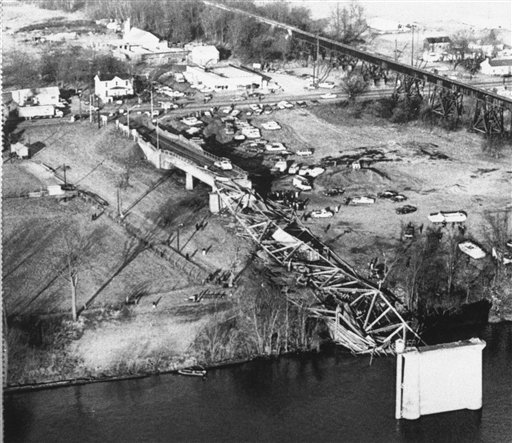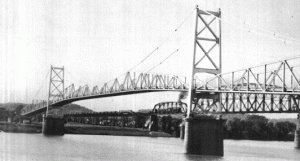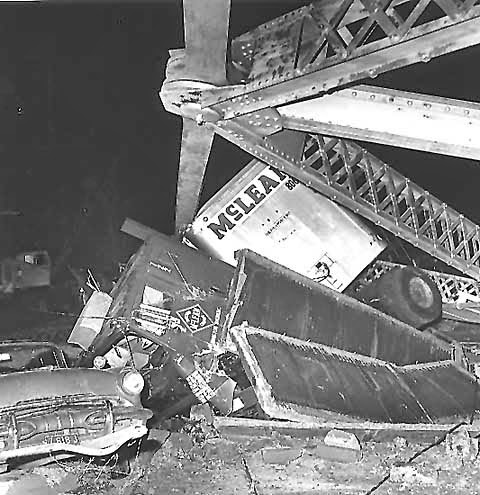Fifty Years Later, Silver Bridge Disaster Remembered

The twisted wreckage of the Ohio River Silver Bridge after it fell. File photo.

MID OHIO VALLEY – Ten days before Christmas, residents from Gallia and Meigs Counties along with Mason County, West Virginia were preparing like the rest of the nation for the upcoming holidays. Some were going to or returning from work while others were enjoying shopping for gifts when the routine day turned tragic.
It was rush hour on December 15, 1967, just at 5 p.m. when “a loud gunshot-like noise” as eyewitnesses described it could be heard coming from the Silver Bridge. Within 20 seconds, it crumpled and collapsed “folding like a deck of cards” into the cold waters of the Ohio River. It took just seconds for the 1,1460-foot suspended portion of the bridge to collapse. The bridge which had opened on Memorial Day in 1928 was just gone.

The bridge was crowded that day. Cars were lined up in both directions. When the Silver Bridge fell 32 vehicles were destroyed and it claimed 46 lives. Two of those victims were never recovered.
For the communities in Gallia, Mason, and Meigs, it was an event which everyone living at the time remembers where they were when they heard the bridge had collapsed. It was devastating. For weeks following the collapse, there was one funeral after another as victims were recovered and laid to rest. Many knew at least one person lost in the disaster.
In the wake of dealing with the tragedy and loss of so many lives, arrangements had to be made to handle the 3,500 to 4,000 vehicles that on average traversed the bridge between Ohio and West Virginia. Local ferry landings were quickly set up and vehicles were ferried back and forth across the Ohio River. Additionally, a shuttle service was set up on the New York Central Railroad upstream. Vehicles were also detoured 14 miles to Pomeroy, Ohio for crossing at the bridge there or down river at the bridge in Huntington, West Virginia.

In addition to the devastating emotional toll and loss the bridge collapse had on the area, the impact economically was nearly as devastating. By February 7, 1968, reports estimated the economic loss to be $1 million a month and then-President Lyndon Johnson stepped in with an order for federal-state programs to start immediate reconstruction. To grasp the devastating economic impact 50 years later, the economic loss would be roughly the equivalent of more than $6.9 million in the present day to the area.

While the National Transportation Safety Board had started an investigation immediately following the collapse, the Presidential Task Force on Bridge Safety also investigated the disaster. The task force began a national survey on bridge safety.
Answers to the disaster were not forthcoming from the safety board, however, until April 6, 1971 when a determination of the collapse cause was issued. The report stated, “a cleavage fracture in the lower limb of the eye of eyebar 330 at joint C13N of the north eyebar suspension chain in the Ohio side span. The fracture was caused by the development of a critical-size flaw over the 40-year life of the structure as the result of the joint action of stress corrosion and corrosion fatigue.”
Further laboratory work identified the failure sequence as “a brittle fracture of the lower half of the eye, then a ductile fracture of the upper half,…resulting (in) pulling…the companion eyebar off the pin which had connected it with the fractured eyebar.” It concluded that, “With the north…chain thus broken, the structure’s design made total collapse…inevitable.”
According to the West Virginia Department of Transportation, the Silver Bridge was designed by J.E. Greiner Company and built by Gallia County Ohio River Bridge Company (later West Virginia-Ohio Bridge Company) and its subcontractor, U.S. Steel’s American Bridge Company. A two-lane, 1760-foot-long eyebar suspension bridge with a 700-foot main span 102 feet above the bottom of the Ohio River channel and two 380-foot anchor spans, it was completed in one year.
Inspections, which had been done by the private owner from 1928 to 1941, were taken over by the State Road Commission. State standards were followed during inspections, which were noted in 1959, 1963 and 1964. Following an inspection in 1965, some $30,000 in recommended repairs were completed. Two more inspections were done in the summer of 1967, with a final visit by the Commission’s area maintenance engineer on December 6. With any large structure like this bridge, it’s so important that regular inspections are done to make sure the structure of the bridge is still secure. Regular maintenance allows inspectors to find any issues before they worsen. If minor issues are spotted, it’s important to fix them right away. Most structural issues can be reported to welders who can repair steel structures with various welding tools. However, when they complete these welding tasks, it’s important for welders to wear proper safety equipment, such as welding coats, to make sure they keep themselves safe whilst they use high temperatures to repair the structure. Regular visits from an inspector should keep this new bridge safe from a similar accident.
With the advent of modern resources and technologies, using a mesh design of stainless steel cables in the construction of side barriers for bridges could not only prove to be cost-effective than using raw materials such as iron, but could also help in future fall preventions, and that way aid in avoiding potential disasters (if you would like you can read more about stainless steel cables here).
Among the Safety Board’s recommendations to the US Secretary of Transportation were expanding or beginning research programs aimed at such areas as identifying susceptible bridge construction materials and developing new inspection equipment and safeguards in selecting materials, design and fabrication of future bridges. Its final recommendation was to “explore alternatives” to assure that federal bridge safety standards be applied to all highway bridges (not just the 165,000 on the federal system but the other 398,000 structures ) and “consider proposing a program of federal-aid funding.”
Despite all this, the hole left in the families effected by the disaster linger to this day. While a bridge was eventually built to replace the Silver Bridge, nothing could replace the lives lost or change the effect the tragedy had on the area.
Memorial Observances
Memorial services will be held Friday, Dec. 15, 2017 to remember those lost and injured in the tragedy. The West Virginia Department of Highways has organized a memorial program for 11 a.m. at the site of the collapse on the Point Pleasant side. A tent will be set up for inclement weather. Directly following the program which will include local and state speakers, there will be a reception with light refreshments at the Trinity United Methodist Church.
The annual memorial observance will take place as well at 5 p.m. at the 6th Street memorial.
Locally, the disaster is still fresh in the minds of many. One man decided to mark the tragedy in song. The link here, leads to Steve and Annie Chapman’s website. The song can be heard along with the an interview with his father, P.J. Chapman, who was a pastor that responded to the tragedy. The Chapman is expected to be part of at least one of the services. The song recalls the Silver Bridge in splendor and the fateful day 50 years ago.
Victims of the Silver Bridge Collapse
Of the 46 lives lost, 44 bodies were recovered. The were: Albert A. Adler, Jr., of Gallipolis, Ohio; J.O. Bennett, of Walnut Cove, North Carolina; Leo Blackman, of Richmond, Virginia; Kristye Boggs and Margaret Boggs of Vinton, Ohio; Hilda Byus and Kimberly Byus of Point Pleasant, West Virginia; Melvin Cantrell, of Gallipolis Ferry, West Virginia; Thomas A. Cantrell, of Gallipolis, Ohio; Donna Jean Casey, of Point Pleasant; Cecil Counts, of Gallipolis Ferry, West Virginia; Horace Cremeans, of Gallipolis, Ohio; Harold Cundiff of Winston-Salem, North Carolina; Alonzo Luther Darst, of Cheshire, Ohio; Alama Duff, of Point Pleasant, West Virginia; James Hawkins, of Westerville, Ohio; Bobby L. Head, of Gallipolis, Ohio; Forrest Raymond Higley, of Bidwell, Ohio; Alva B. Lane, of Gallipolis, Ohio; Thomas “Bus” Howard Lee, of Gallipolis, Ohio; G. H. Maybe, of Jamestown, North Carolina; Darlene Mayes, of Kanuga, Ohio; Gerald McMannus, of South Point, Ohio; James Richard Maxwell, of Gallipolis, Ohio; James F. Meadows, of Point Pleasant, West Virginia; Timothy Meadows, of Point Pleasant, West Virginia; Frederick D. Miller, of Gallipolis, Ohio; Ronnie G. Moore, of Gallipolis, Ohio; Nora Isabelle Nibert, of Gallipolis Ferry, West Virginia; Darious E. Northup, of Gallipolis Ferry, West Virginia; James O. Pullen, Middleport, Ohio; Leo “Doc” Sanders, of Point Pleasant, West Virginia; Ronald Sims, of Gallipolis, Ohio; Charles T. Smith, of Bidwell, Ohio; Oma Mae Smith, of Bidwell, Ohio; Maxine Sturgeon, of Kanauga, Ohio; Denzil Taylor and Glenna Mae Taylor, of Point Pleasant, West Virginia; Robert Eugene Towe, of Cana, West Virginia; Victor William Turner, of Point Pleasant, West Virginia; Marvin Wamsley, of Point Pleasant, West Virginia; Lillian Eleanor Wedge and Paul D. Wedge of Point Pleasant, West Virginia; and James Alfred White, of Point Pleasant, West Virginia.
The bodies of Kathy Byus and Maxine Turner, both of Point Pleasant, West Virginia were never recovered.
The construction of bridges is a dangerous undertaking due to the heights involved that workers need to be at for lengthy periods of time. Workers should undergo training in safety at heights before beginning a project. Such courses can be found here – view website






